We have two Robins visit our garden, one is currently rotund, one is svelte. Apart from girth neither of our visitors have any distinguishing marks. Male and females are almost identical. Usually breeding begins in March with the first clutch laid in April but our mild winter will probably lead to an earlier courtship. I’ve read that females require more body weight for producing eggs, so I have fingers crossed that Rotund is a female.
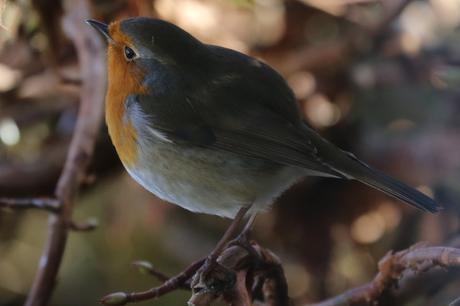
Rotund Robin (Erithacus rubecula) who we hope is a female
In colder weather both sexes plump up their feathers for insulation and warmth, but when seen at the same time, its clear one is much rounder than the other. So far, there’s no activity in the nest box but Robins create nests in all sorts of odd places, we are fairly sure there is activity in the potting shed, mainly due to the additional droppings on the potting bench. But what’s a little poop between a gardener and her friends!
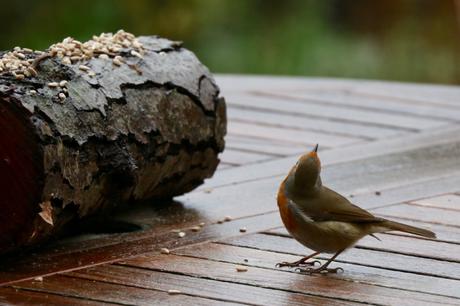
Svelte looking alert.
Renown as territorial birds, both males and females defend their individual patches all year round and once united defend their joint territory for the summer months, parting after their chicks fledge. Last week we watched Svelte defending his territory, eyes to the sky, he had heard the incomer before us and was waiting for the newbie to land, but he wasn’t really aggressive and believe it could have been Rotund landing on the table.
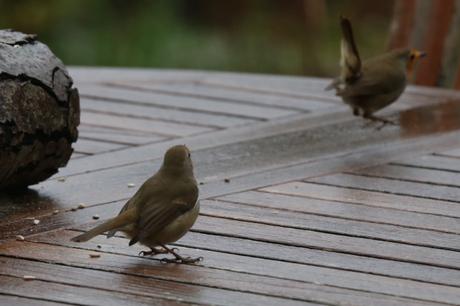
The newcomer turning tail on puffed up Svelte
There wasn’t a fight as such, just a baring of his Red Breast, which we read they only do to defend territory, however we have also read in our well thumbed RSPB ‘Handbook of British Birds’, that Robins “have elaborate courtship displays when the red breast of the male is used as a visual signal to attract females and deter males”. Either way, the newcomer hopped off.
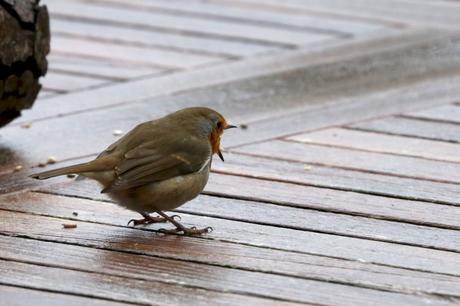
Making his presence known
I couldn’t quite make out what was being said here, but following the encounter Svelte let out a cry of frustration/warning/who knows? The following day Newcomer came back again to try his/her luck, Svelte postured with head high and lots of red breast baring, despite the wind blowing his feathers apart. We could see no real aggression and the 2nd bird crouched on the ground watching quietly.
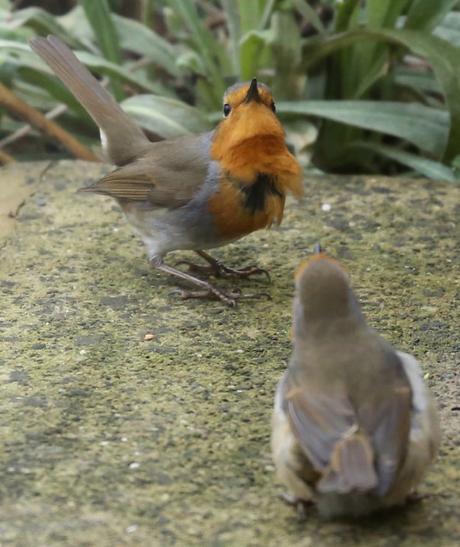
Is this just a partial threat?
Newcomer remained crouched on the ground watching Svelte posture about for a few minutes, Svelte then turned tail and Newcomer flew after him. I’ve read of fights to the death and just hope they both came to a gentleman’s agreement, but nature can be cruel and the brutal fights part of life’s cycle.
(Or as the RSPB book suggests, this is maybe courtship and Newcomer is actually Rotund – her crouching down is the mimicking of a chick and they were off to the bushes for some privacy? – time will tell.) Males chase females from their territories for some days until finally the male accepts her and they become a couple.
Some while later, a slim Robin we assume was Svelte resumed feeding, happy to share fatballs with Blue Tits. Robins are only territorial with their own kind and the only birds we see being chased off are the dowdy, timid ground feeding Dunnocks.
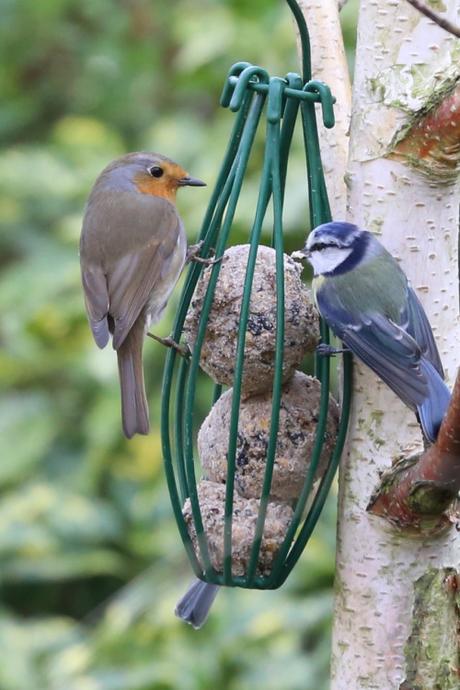
Feeding alongside the Bluetits
If we do have a couple, there will be courtship feeding – the male feeds the female, apparently its a prominent activity, we are desperately hoping to see this and then will know for sure if who is male and who is female. The male can supply over a third of his mates food intake during nest building and egg laying. She alone is the creator of a cup shaped nest, made of dead leaves and moss, lined with hair. To help her we have saved our Labrador’s soft underbelly hair for months and have placed the soft hair in a mesh feeder ready for all nest builders.
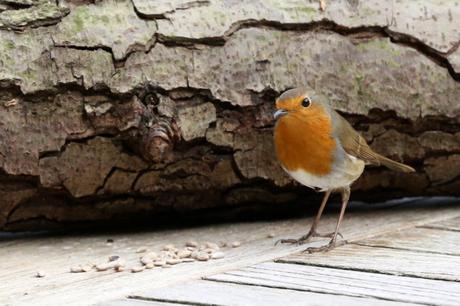
Svelte looking trim
The RSPB report that the parental instinct in Robins is highly developed and they are known to feed the chicks and fledglings of other bird species, including Song Thushes, Blackbirds, Spotted Flycatchers and Willow Warblers, the latter two we do not see but we have had Blackbirds nest in our garden. I guess Robins would only be able to step in if they had no brood of their own. We would be thrilled if these two were a couple and over the moon if there were nesting, egg laying and hopefully successful fledgelings.
I’m joining in with Tina’s My Gardener Says meme Wildlife Wednesday, where lots of other folk from across the globe are sharing their wildlife experiences.
Happy Wildlife Wednesday!
